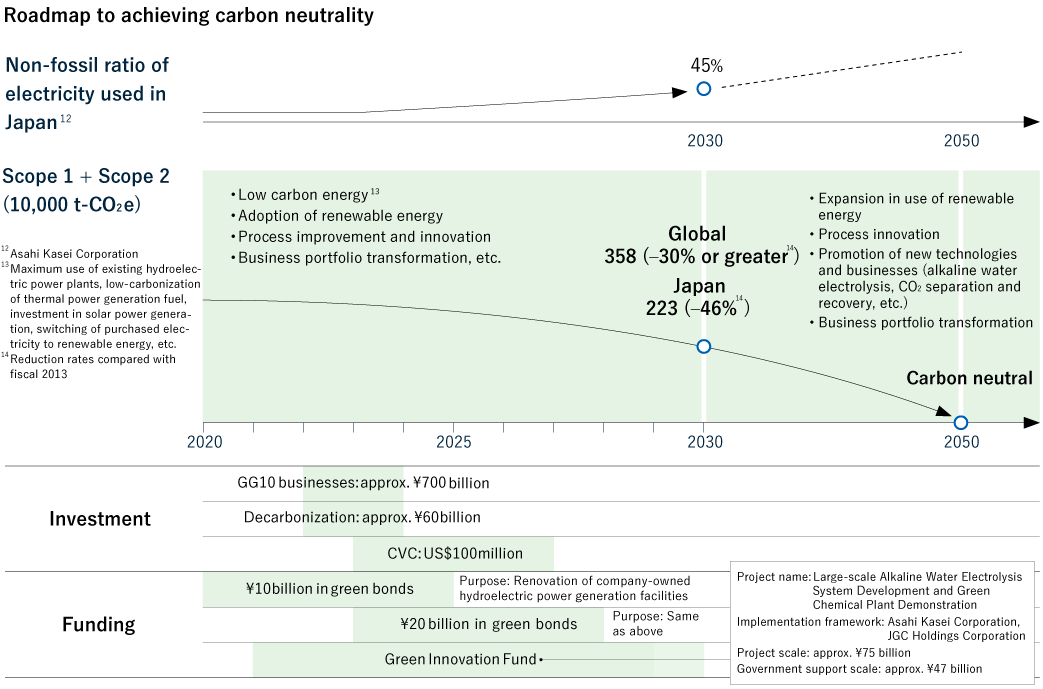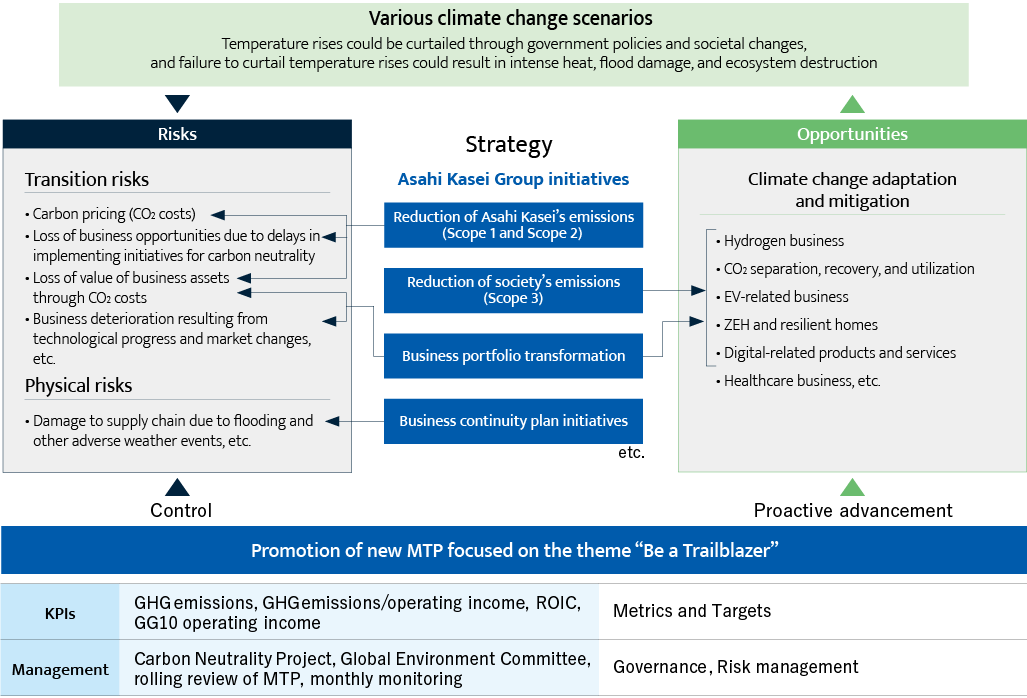Climate Change
Asahi Kasei Group's Carbon Neutrality Policy
In accordance with its Group Mission, the Asahi Kasei Group is committed to contributing to life and living for people around the world. The Asahi Kasei Group has long been aware that climate change is a global issue that will have a significant impact on both the natural environment and society, and we see it as our mission to use the scientific expertise we have cultivated since our founding to deal with this issue leveraging our combined strength.
In May 2021, the Asahi Kasei Group adopted a policy for carbon neutrality.
Greenhouse gas (GHG) emission targets for the Asahi Kasei Group
- 2050
- Carbon neutral
- 2030
- Emissions reduction of 30% or more (from fiscal 2013)*
- *Scope 1 (direct GHG emissions) and Scope 2 (indirect emissions use of electricity, heat, and steam supplied by other companies), absolute quantity
Initiative Policy
In addition to reducing GHG emissions from our own business activities, we believe that it is also important to help to reduce GHG emissions in society through our diverse array of technologies and businesses to deal with climate change. We launched a Green Solution Project in April 2021 to study creating new businesses for carbon neutrality.
In April 2022, we launched a Carbon Neutrality Project to share and discuss scenario analysis and consolidate efforts to achieve our 2030 GHG emission reduction targets and carbon neutrality by 2050.
Regarding "Care for Earth," we are committed to addressing climate change issues group-wide, both in terms of (1) reducing the amount of GHGs emitted by our own business activities and (2) helping to reduce GHGs throughout society through our businesses and technologies.
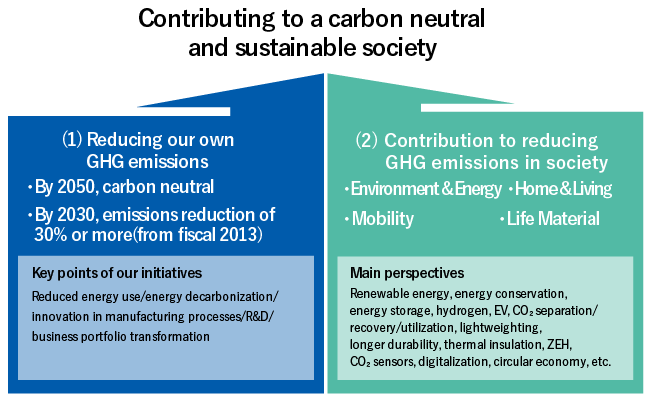 Key Points of Effort for Carbon Neutrality
Key Points of Effort for Carbon Neutrality
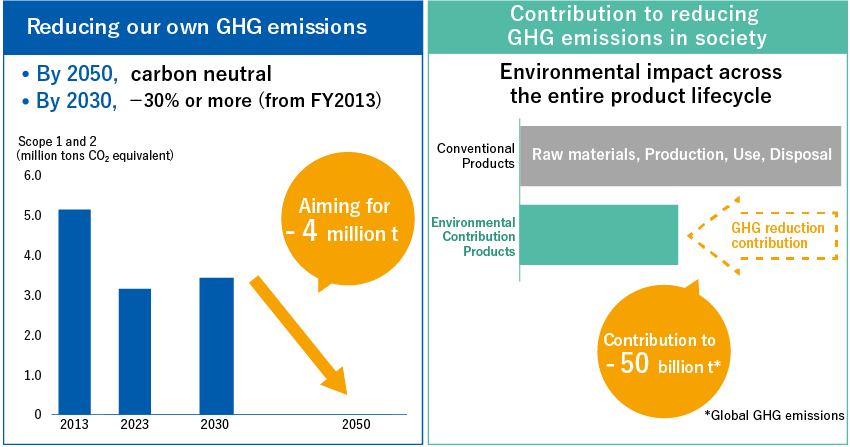 Two Initiatives for GHG Reduction
Two Initiatives for GHG Reduction
- The Asahi Kasei Group's ESH & QA and Health Management Policy
- The Asahi Kasei Group's Global Environmental Policy
Reducing GHG Emissions
Concrete GHG reduction measures and their projected impacts
We are targeting a reduction in GHG emissions by at least 30% by 2030 as compared to fiscal 2013, with a goal of becoming carbon neutral by 2050. Measures will be advanced as described below.
In the first stage, by 2030 we aim to reduce our GHG emissions by approximately 300 thousand tons by adopting low-carbon methods for in-house power generation, by 100 to 200 thousand tons through the purchase of non-fossil fuel power, and by 100 to 200 thousand tons by curtailing emissions from our manufacturing processes. We will also promote GHG emissions reductions through transformation of our business portfolio, etc.
In the second stage through 2050, we will work toward greening both electricity and steam and the introduction of innovative processes through practical application of technologies developed by Asahi Kasei, such as alkaline water electrolysis and CO2 separation and recovery. In addition, we will promote further transformation of our business portfolio, etc., and move forward with reductions toward attainment of our objectives.
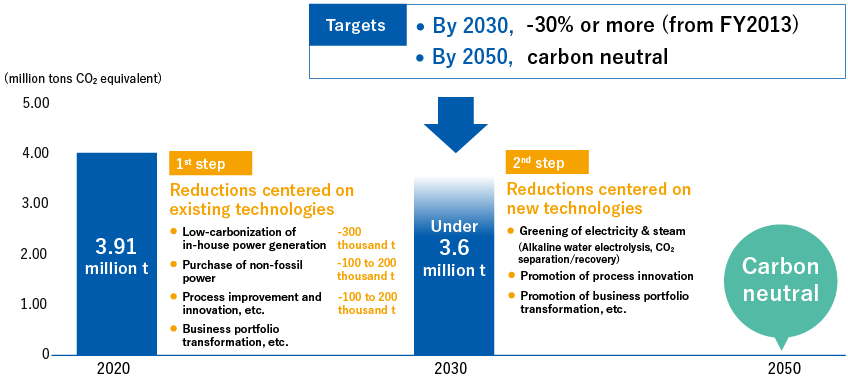 GHG emissions
GHG emissions
Scope 1 and 2 GHG emissions
All production sites of Asahi Kasei Corp. and its consolidated subsidiaries under management control are subject to calculation of Scope 1 and Scope 2 GHG emissions of the Asahi Kasei Group, and GHG emissions from generation of electricity and steam sold outside the Asahi Kasei Group are included.
In fiscal 2022, our Scope 1 GHG emissions were 2.83 million tons of CO2-eq![]() , and Scope 2 GHG emissions were 0.83 million tons of CO2-eq
, and Scope 2 GHG emissions were 0.83 million tons of CO2-eq![]() , bringing the total of Scope 1 and 2 to 3.67 million tons of CO2-eq
, bringing the total of Scope 1 and 2 to 3.67 million tons of CO2-eq![]() . This is a reduction in GHG emissions of approximately 28% compared to the 5.11 million tons of CO2-eq released in the baseline year of 2013.
. This is a reduction in GHG emissions of approximately 28% compared to the 5.11 million tons of CO2-eq released in the baseline year of 2013.
- *Figures with
 have received independent assurance by KPMG AZSA Sustainability Co.,Ltd. (March 2024 updated)
have received independent assurance by KPMG AZSA Sustainability Co.,Ltd. (March 2024 updated)
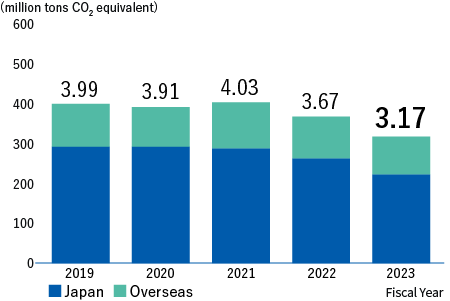 GHG emissions*
GHG emissions*
*77.7% coverage (company sales included in GHG emissions calculation / total consolidated sales x 100)
- Global greenhouse gas emissions by segment (ESG Data)
- Overseas greenhouse gas emissions by fiscal year (ESG Data)
Global Scope 3 emissions*
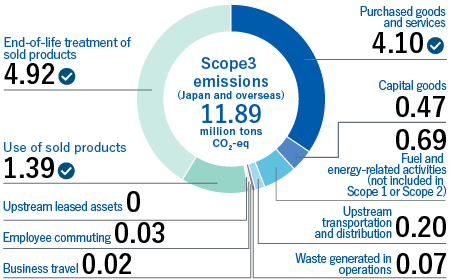 Global Scope 3 emissions
Global Scope 3 emissions
- *Figures with
 have received independent assurance by KPMG AZSA Sustainability Co.,Ltd. (March 2024 updated)
have received independent assurance by KPMG AZSA Sustainability Co.,Ltd. (March 2024 updated) - *Scope 3 emissions: Greenhouse gases emitted indirectly by a company throughout its supply chain. The methods for calculating Scope 3 emissions from Category 1, 5, 11 and 12 are described in Environmental data.
Efforts to Reduce CO2 Emissions
Renewable energy
The Asahi Kasei Group has 9 hydroelectric power generation plants in the Nobeoka Region, which provided approximately 6% of the total electricity we used both in Japan and overseas. Generation of the equivalent amount of purchasing electricity would result in approximately 60 thousand tons* of CO2 emissions annually.
We also have a biomass power generation facility.
- *Using Japan's Ministry of Economy, Trade and Industry and Ministry of the Environment, Order No. 3 of 434g CO2/kWh.
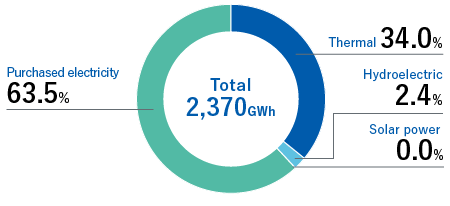 Electricity sources, FY2022 (global)
Electricity sources, FY2022 (global)
The table below shows the amount of renewable energy purchased and generated.*1
| Type of energy | Unit | FY2022 |
|---|---|---|
| Hydroelectric power generation | MWh | 106,289 |
| Solar power generation | MWh | 56 |
| Biomass-based*2generation | MWh | 63,870 |
| Purchased non-fossil certificates | MWh | 18,305 |
| Biomass-based*2steam | GJ | 348,448 |
- *1Hydroelectric power generation with no environmental value under the FIT system is excluded from the tally.
- *2The calculation is made by multiplying the amount of electricity and steam generated by the input ratio of biomass fuel in the co-combustion power generation of biomass and coal.
- *Figures with
 have received independent assurance by KPMG AZSA Sustainability Co.,Ltd. (March 2024 updated)
have received independent assurance by KPMG AZSA Sustainability Co.,Ltd. (March 2024 updated)
Using Renewable Electricity in the Homes Business
As part of its efforts to address climate change, Asahi Kasei Homes joined the RE100 Initiative in 2019, aiming to achieve sustainable urban living with both decarbonization and resilience.
Asahi Kasei Homes has a target of procuring 100% of the electricity consumed for its business activities from renewable energy sources, and is on track to achieve this in 2025, significantly sooner than the initial outlook of 2038.
Domestic energy saving in logistics
The Asahi Kasei Group promotes environmentally friendly railway shipment.
Product shipments for our operations in Japan amounted to some 1.0 billion ton-kilometers in fiscal 2022―an 5% decrease from fiscal 2021―generating approximately 77 thousand tons of CO2 emissions―a 9% decrease. In cooperation with the transport firms contracted for shipment, a wide range of measures are employed to reduce energy consumption and alleviate the environmental effects of physical distribution.
We have received Eco-Rail Mark certification in recognition of our preferential shipment of products by rail, an ecological mode of transport which results in lower CO2 emissions for a given weight and distance than many other means of transportation.
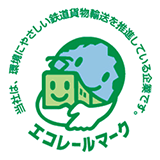
Domestic promotion of low emission vehicles
The Asahi Kasei Group is phasing in low-pollution vehicles for use in marketing and within plant grounds. In fiscal 2022, some 91% of company-owned vehicles were low-pollution vehicles.
Asahi Kasei green bond
Please see here for more details.
Climate Change Initiatives (Disclosure based on TCFD1 Recommendations)
Awareness surrounding climate change
The IPCC’s2 Sixth Assessment Report, released in March 2023, pointed out that global average temperatures have already risen by 1.1°C since the Industrial Revolution, and that even if all national greenhouse gas (GHG) reduction targets are met, the Paris Agreement's goal of keeping the temperature rise to less than 1.5°C by the end of this century will not be achieved. Against this backdrop, the G7 Ministers’ Meeting on Climate, Energy and Environment which was held in April 2023 issued a communique saying, “We underscore our commitment to implementing immediate, short- and medium-term action in this critical decade.”
The Asahi Kasei Group recognizes that there is a growing sense of crisis around the world over the progress of global warming, and that policies for adaptation and mitigation are accelerating.
Asahi Kasei’s stance
Over the century since our founding, we have developed our business by challenging ourselves in response to the social issues that have changed with the times, transforming ourselves in the process. At this time of great upheaval, when climate change is an issue for the entire social system, we will continue to work toward the goal of a carbon-neutral society by 2050 while transforming our business portfolio and improving productivity through our medium-term management plan for fiscal 2024 focused on the theme “Be a Trailblazer.”
Additionally, we will continue to steadily reduce our greenhouse gas emissions (Scopes 1 and 2), and further work to reduce emissions throughout the entire supply chain, including Scope 3 emissions.
- 1 TCFD: Task Force on Climate-related Financial Disclosures. TCFD was established and its recommendations were officially announced by the Financial Services Board in 2017.
- 2 Intergovernmental Panel on Climate Change
Governance
Asahi Kasei consider green transformation (GX), which focuses on initiatives related to climate change, to be an important management issue, and we are working toward GX by positioning it as one of the core subjects of our management strategy.
Our climate change policy and high priority concerns are deliberated on and determined by the Board of Directors, while specific matters relating to these areas are deliberated on and determined by the Management Council, our decision-making body for business execution.
Main deliberations and decisions:
- GHG emissions reduction targets, results, and measures
- Medium-term management plan, progress/results, and measures
- Investment plans (taking point of view regarding GHG emissions into account), etc.
In formulating the medium-term management plan and annual business plans, business units and corporate divisions discuss matters related to GX, including emissions reductions, and after group-wide plans are aggregated, proposals are made to the Management Council and Board of Directors for deliberation and decision-making.
In order to promote these decisions by the Board of Directors and Management Council at a business level, we have a Sustainability Committee chaired by the President, where members of executive management share and discuss issues concerning sustainability, including climate change. Results of Sustainability Committee meetings are reported to the Board of Directors, which discusses topics including appropriate company-wide initiatives.
Additionally, in fiscal 2022, we considered scenarios for achieving our GHG reduction targets within a dedicated project (Carbon Neutrality Project) under the direction of an Executive Officer. In reviewing scenarios, the President, Executive Officer for Corporate Strategy, and others regularly discuss the course of action and work to strengthen initiatives.
In the Materials and Homes sectors, we have established sustainability departments within strategic business units and core operating companies where initiatives are being worked on toward carbon neutrality and a circular economy in collaboration with business units and the Group-wide sustainability department.
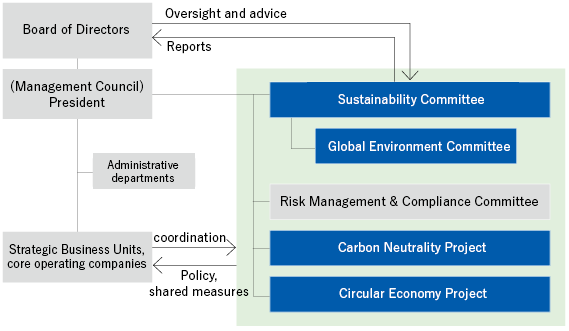
Sustainability Committee
- Sharing, discussion, and alignment of all aspects of ESG, including climate change
- Chair: Asahi Kasei President
Committee members: Executive Officer for Technology Functions, Executive Officer for Business Management Functions, Executive Officers for the 3 business sectors - Main topics in fiscal 2022: carbon neutrality, circular economy, natural capital, human rights, etc.
Global Environment Committee
- Sharing, discussion, and alignment of all aspects of the E (Environment) of ESG
- Chair: Executive Officer for Technology Functions (Environment & Safety)
Committee members: Presidents of SBUs, Senior General Manager of the Production Center, Senior General Manager of Corporate Production Technology, Senior General Manager of Corporate Research and Development, and others
Carbon Neutrality Project
- Sharing and discussing 2030 GHG reduction targets, consolidating efforts towards 2050 carbon neutrality, and scenario analysis
- Project oversight: Executive Officer for Carbon Neutrality, Project General Manager
Strategy
Underlying assumptions
While a variety of scenarios can be envisaged, depending on the progress of measures to counter global warming, we have analyzed the following two representative scenarios.
- A scenario in which CO2 emissions are strictly controlled in order to limit the temperature rise to 1.5°C above pre-industrial levels (WEO: Net Zero Emissions by 2050 Scenario [NZE]3)
— We consider strengthening of regulations and significant transformation of society and markets as the baseline transition risk scenario - A scenario in which measures to counter global warming make insufficient progress and temperatures rise by 4°C (IPCC SSP3-7.04)
— We consider extreme weather events and changes to society and ecosystems as the baseline physical risk scenario
With reference to each of these scenarios, we explored impacts on our current business toward 2050, as well as new opportunities.
- Note: These analyses are based on a variety of assumptions, and changes to these assumptions may result in actual risks and opportunities differing significantly.
- 3 One of the scenarios listen in the International Energy Agency (IEA)’s WEO (World Energy Outlook) 2022. A scenario that will allow us to achieve worldwide net-zero in 2050 in order to limit the temperature increase to 1.5°C by 2100.
- 4 One of the scenarios in the sixth report of the Intergovernmental Panel on Climate Change (IPCC). “SSP” stands for “Shared Socioeconomic Pathway” and the SSP3-7.0 is a scenario in which regional rivalry results in climate policies not being adopted, and temperatures rise by up to 4°C in 2100.
Opportunities
Asahi Kasei is working to transform its business portfolio in light of megatrends such as the transition to a carbon-neutral society. Specifically, the medium-term management plan sets out 10 growth-driving businesses, referred to as "10 Growth Gears" (GG10), to which we will focus resources with a target of decision-making for investment of approximately ¥600 billion in these businesses over three years.
In particular, we will focus management resources on hydrogen-related business, battery separators, digital solutions, and critical care. We also plan to invest approximately ¥60 billion over the three years until fiscal 2024 on decarbonization-related areas.
In addition, we have established an investment framework of $100 million over the five-year period from fiscal 2023-27, targeting startup companies in the environmental field, which includes efforts to address climate change. From the perspective of the overall supply chain, we have set a goal of increasing the percentage of sales of products and services (Environmental Contribution Products) that help to reduce the world’s GHG emissions, and more than double the amount of GHG reduction contribution by fiscal 2030 compared to fiscal 2020 levels.
We recognize that the direction of our business development can provide business opportunities with a variety of products and services in climate change mitigation and adaptation.
-
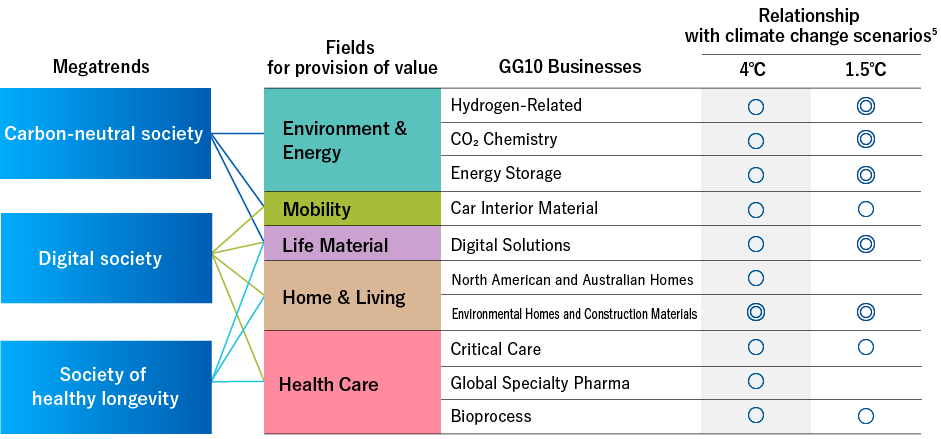
- 5 Items judged highly relevant, including those directly addressed in the IPCC’s Sixth Assessment Report and the WEO 2022, indicated by double circle: ◎
- Items not covered by the above, but estimated to be broadly related indicated by single circle: ○
For example, the battery and hydrogen markets are expected to grow significantly in order to achieve carbon neutrality by 2050. These two areas are among Asahi Kasei’s highest priority business fields.
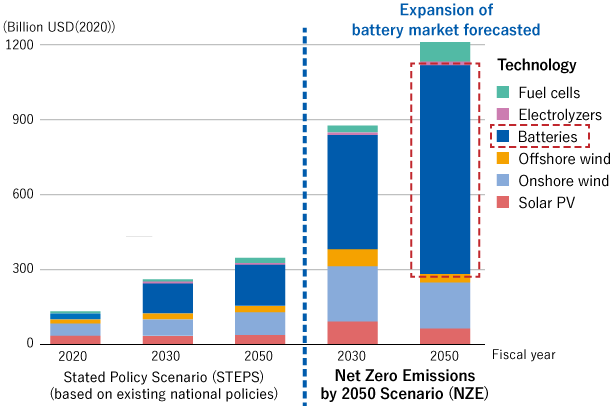 Estimated market size for various clean energy technologies (2020–2050)6
Estimated market size for various clean energy technologies (2020–2050)6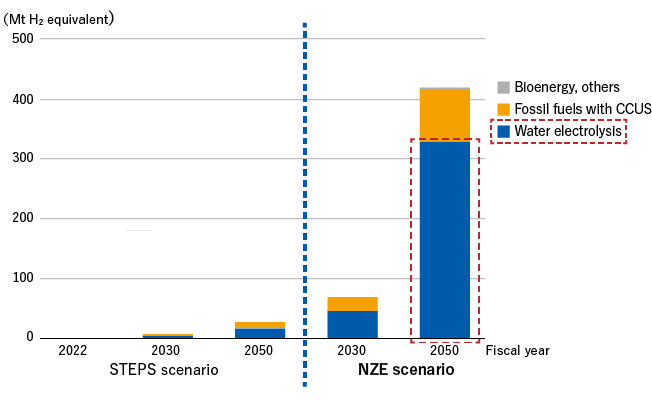 Outlook for the low GHG emissions hydrogen production market (2021-2050)7
Outlook for the low GHG emissions hydrogen production market (2021-2050)7
- 6 Graphs by Asahi Kasei based on the IEA’s World Energy Outlook 2021. Furthermore, according to World Energy Outlook 2022, the demand for batteries in the transportation sector under the NZE scenario will increase over 16 times between 2021 and 2030.
- 7Graphs by Asahi Kasei based on the IEA’s World Energy Outlook 2022.
| Opportunities | |||
| Important Changes | Main opportunities | Principal initiatives, Products | |
| +1.5°C scenario | Transition to a carbon-neutral society |
・Promotion of the spread of Net Zero Energy Homes (ZEH8 and ZEH-M8) through government policies ・Increasing demand for renewable energy ・Increasing need for energy conservation ・Increasing demand for carbon-neutral products |
・Move to carbon-neutral homes and communities through expansion of ZEH-compatible Hebel Haus* and Hebel Maison* ・Move to carbon-neutral energy (Hebel Electric*) ・Energy conservation, process innovation (chlor-alkali electrolysis, Neoma Foam*, etc.) ・Use of biomass in raw materials (basic chemicals derived from bioethanol9, biomass certified products) ・Chemical products using CO2 as raw material (polycarbonate, LIB electrolyte components, etc.) ・Development of Environmental Contribution Products ・Promoting decarbonization and enhancing competitiveness by ascertaining the carbon footprint10 of products |
|---|---|---|---|
| Spread of electric vehicles (EVs) | ・Increase in EV-related demand (Battery components, materials for reducing vehicle weight) |
・Development and provision of components/systems for the next-generation mobility society (engineering plastics, electronic components, etc.) ・Strengthening of collaboration with automobile and battery manufacturers (LIB separators, car interior fabrics, etc.) |
|
| Advent of a hydrogen society | ・Increased demand for water electrolysis that utilizes renewable energy | ・Development and commercialization of green hydrogen production systems (alkaline water electrolysis) | |
| Transition to a circular economy |
・Growing demand for components compatible with a circular economy ・Development of circular economy infrastructure |
・Development of material recycling and chemical recycling technologies, promotion of their practical application ・Use of biomass raw materials (basic chemicals derived from bioethanol9, biomass-derived polyamide 66) ・Providing long-life homes (Hebel Haus*, Hebel Maison*, remodeling*, used Hebel Haus brokerage*) |
|
| Expansion of the digital market | ・Digital solutions for carbon neutrality in society, life, and industry | ・Promotion of business in electronic devices, such as current sensors and CO2 sensors, and semiconductor and substrate-related electronics materials | |
| +4°C scenario | Serious storm and flood damage | ・Increasing need for disaster-resilient housing | Enhancing resilience of homes and communities, including Hebel Haus* and Hebel Maison* |
| Rise in temperature | ・Increasing needs for better insulation | ・Providing insulation materials and housing with superior insulation (Neoma Foam*, Hebel Haus*, Hebel Maison*, remodeling*) | |
| Higher incidences of heat stroke and infectious diseases | ・Increased demand for existing medicines, new medicines, and the critical care business | ・Provision of emergency medicines and medical equipment for infectious diseases and heat stroke | |
- *:Japanese Document
- 8ZEH (Net Zero Energy House) and ZEH-M (ZEH-Mansion): Houses and apartment buildings with a net energy consumption of zero or less as a result of advanced insulation and energy saving combined with power generation such as solar
- 9 Asahi Kasei sustainability briefing materials (January 2023), p. 15
- 10A product’s GHG emissions from material extraction to production
Risks
Based on these scenarios, we have analyzed the climate change risks to Asahi Kasei from various perspectives.
In a scenario in which global temperatures rise by 1.5°C, we primarily anticipate risk in the form of a shift in demand toward materials conducive to carbon neutrality, alongside strengthening of regulations through carbon pricing and other policies aimed at moves toward carbon neutrality. We also anticipate risk in the form of changes in market structures brought about by an accelerating transition to a circular economy and the advent of innovative technologies aimed at carbon neutrality.
In a scenario in which global temperatures rise by 4°C we primarily anticipate physical risks such as intense heat, heavy rain, and flooding. In particular, we perceive damage to production sites caused by the effects of increasingly severe storms and floods and the resultant cost of such damage to be a risk for our major sites in Japan and overseas.
While the above risks vary in their intensity, we view all of them as having the potential to arise amid the climate change to come, and we will continue to pursue risk reduction initiatives.
| Risks | |||
| Important Changes | Main Risks | Principal initiatives | |
| +1.5°C scenario | Transition to a carbon-neutral society | ・Cost increases due to more stringent regulations (manufacturing costs, raw material costs)
・Changes in materials needs (carbon-neutral needs, required specifications)
|
Promotion of action for carbon neutrality ・Expansion in utilization of renewable energy, etc. ・More efficient energy use, development and practical application of innovative industrial processes ・Biomass in raw materials ・Accelerating move to carbon-free products by ascertaining carbon footprint ・Review of management resource allocation (including business portfolio transformation) |
|---|---|---|---|
| Changes in market structures | ・Contraction of existing markets due to transition to a circular economy
・Contraction of existing markets due to the advance of alternative technologies
|
・Development of material and chemical recycling technologies, promotion of their practical application ・Adoption of biomass feedstock ・Review of management resource allocation (including business portfolio transformation) |
|
| +4°C scenario | Serious storm and flood damage | "Physical" production risks ・Suspension of production due to plant damage ・Disruption of raw material supply network due to suppliers suffering from disasters
|
・Continuous revision of BCP and reinforcement of preemptive response (review inventory levels, consider switching to multiple suppliers/locations, etc.) |
| Rise in temperature | "Human" production risks ・Deterioration of working environment and productivity at construction sites
|
・Promotion of heat stroke prevention measures at construction sites ・Promotion of industrialization and utilization of IT in housing construction |
|
- 11 Asahi Kasei GHG emissions in 2022 (Scope 1 and 2 preliminary figures): 3.68 million t-CO2e. When the carbon cost is set at ¥15,000/t-CO2, with reference to the CO2 price level in 2030 by NEZ scenario of WEO 2022,etc.
Risk management
Asahi Kasei positions climate change risk as a Material Group Risk, and as such, climate change risk management is a key priority.
As well as understanding GHG emissions results once a year with third-party assurance, the results, together with progress toward our targets, are shared with the Sustainability Committee and its subcommittee the Global Environment Committee with future initiatives discussed and confirmed.
In addition, during the formulation of medium-term management plans and annual reviews, we confirm initiatives to reduce GHG emissions, linking them to business strategies and measures. Related matters are also assessed on a quarterly and monthly basis.
In terms of capital investment, profitability is evaluated and implementation is decided in light of our internal carbon pricing system. Furthermore, in July 2023, we raised our internal carbon pricing from ¥10,000/t-CO2 to ¥15,000/t-CO2 in order to further promote actions toward carbon neutrality.
Metrics and goals
Asahi Kasei considers the following metrics to be related to climate change opportunities and risks.
| GHG emissions13 |
|
|---|---|
| GHG emissions13/operating income | (Fiscal 2022 result: 2,900 tons CO2e/¥100 million) Interpreting this metric: a decrease indicates a lower carbon tax risk |
| ROIC | By around 2030, 10% or more of total operating income (fiscal 2022 results: 4.0%) Interpreting this metric: an increase indicates progress toward becoming a high-earnings enterprise capable of adapting to change |
| Operating income of the GG10 | By around 2030, 70% or more of total operating income (fiscal 2021 results: 35%) Interpreting this metric: indicates expansion of related businesses able to contribute to tackling climate change |
Others
| Internal carbon pricing | ¥15,000//t-CO2, utilized in our investment decision-making, awards program, etc. |
|---|---|
| Incorporation of climate change issues into remuneration of executives | Attainment of “promoting sustainability,” including initiatives related to tackling climate change, reflected in performance-linked remuneration |
- 13 Includes Scope 1 GHG emissions directly linked to Asahi Kasei business activities (our own direct GHG emissions) and Scope 2 emissions (indirect emissions arising from use of electricity, heat, and steam supplied by other companies)
Global greenhouse gas emissions by segment (ESG Data)

